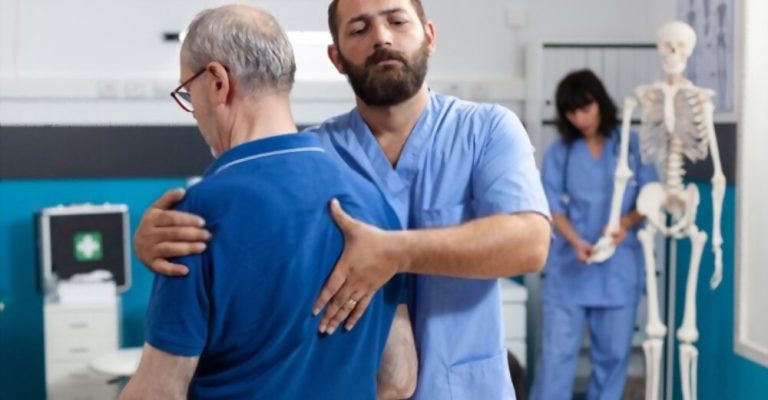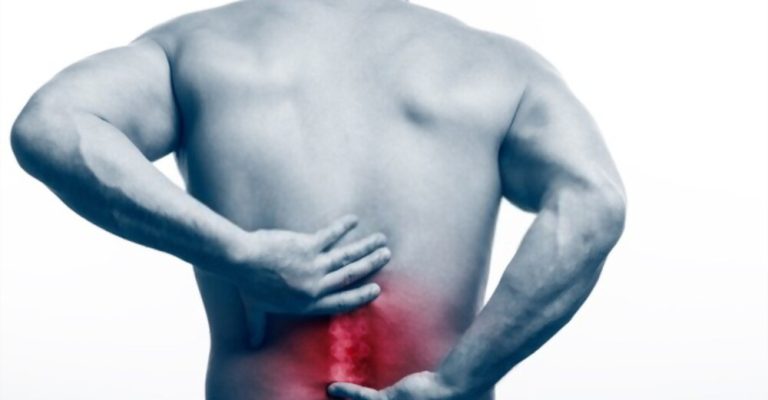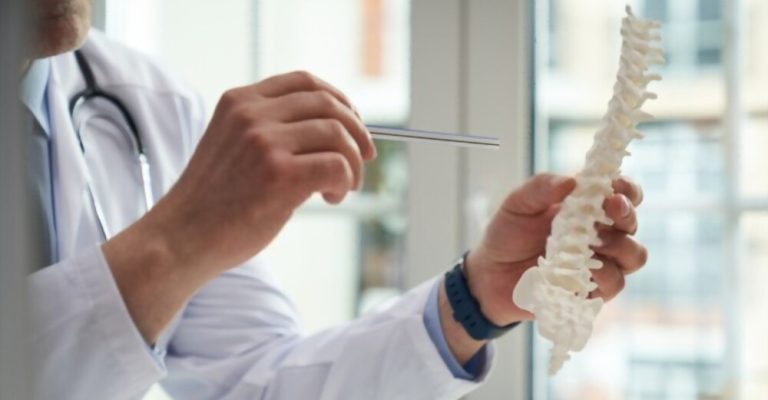
When it comes to the life-altering challenges of a T12 spinal cord injury, patients are often overwhelmed by the sudden shift in physical abilities and the emotional and psychological implications that come with it. A T12 SCI will affect every individual differently, as well as their overall prognosis.
For this reason, understanding both the short-term and long-term impacts such an injury can have on daily life is crucial for those looking to take control of their healing process. In this blog post, we will discuss in detail how a T12 spinal cord injury affects daily functioning and a potential prognosis for individuals living with paralysis below that particular vertebrae level.

When someone experiences a T12 spinal cord injury, there are a number of muscles that can be affected. The T12 spinal cord segment is located in the lower back and controls the movements and sensations of several essential muscle groups. Some of these muscles include the hip flexors, abdominal muscles, the adductors or inner thigh muscles, and the gluteal muscles.
Hip flexors are responsible for helping to lift the leg at the hip joint. They include the iliopsoas muscles and the rectus femoris muscle, which work together to produce this movement. These muscles are essential for many daily activities, such as walking, running, and climbing stairs. When the T12 spinal cord is injured, the hip flexors may become weaker or completely paralyzed, affecting these movements.
Another muscle group that can be affected by a T12 spinal cord injury is the abdominal muscles. This group includes the rectus abdominis, obliques, and transversus abdominis muscles. The abdominal muscles are responsible for stabilizing the trunk and producing movement of the torso. When the T12 spinal cord is injured, the abdominal muscles may become weaker or paralyzed, affecting a person’s ability to sit up or maintain balance when standing.
The adductors, or inner thigh muscles, are also affected by a T12 spinal cord injury. This group includes the pectineus, adductor brevis, adductor longus, adductor magnus, and gracilis muscles. These muscles are responsible for bringing the legs together and rotating the hips. When the T12 spinal cord is injured, the adductors may become weaker or paralyzed, affecting a person’s ability to walk properly.
A T12 spinal cord injury typically affects the muscles and functions below the level of the injury. The T12 vertebra is located in the lower thoracic region of the spine, and damage to the spinal cord at this level can result in varying degrees of impairment or loss of function.
Here are some of the muscles that may be affected by a T12 spinal cord injury:
The T12 level innervates the lower abdominal muscles, including the transversus abdominis and internal and external oblique muscles. Depending on the extent of the injury, these muscles may be weakened or paralyzed, leading to difficulties with trunk stability, core control, and overall abdominal strength.
The T12 level also innervates specific hip muscles, such as the hip flexors (psoas major, iliacus), hip adductors (adductor longus, adductor brevis, adductor magnus), and hip extensors (gluteus maximus). Damage to the spinal cord at T12 can result in varying degrees of weakness or paralysis in these muscles, affecting hip stability, walking, and standing.
The erector spinal muscles, including the spinalis, longissimus, and iliocostalis, receive innervation from the T12 level. A T12 spinal cord injury can impact these muscles, leading to weakened or paralyzed lower back muscles. This can affect posture, balance, and overall back strength.
The pelvic floor muscles, which play a role in controlling bladder and bowel function, may also be affected by a T12 spinal cord injury. Damage at this level can result in weakened or impaired control over these muscles, potentially leading to urinary or fecal incontinence.
It’s important to note that the extent of muscle involvement and functional impairment can vary depending on the severity and level of the spinal cord injury. The above list provides a general overview, but individual cases may have additional factors influencing muscle function and overall recovery.

A T12 spinal cord injury will impair your ability to feel and move your limbs. Some potential issues for those with T12 SCIs are discussed below.
Pressure ulcers, also known as bedsores or pressure sores, can be a common T12 spinal cord injury complication. Pressure ulcers occur due to prolonged pressure on the skin, usually over bony prominences, such as the hips, heels, elbows, and sacrum.
When the skin is subjected to constant pressure, it can impede blood flow to the area, leading to tissue damage and ulcers. Other factors contributing to pressure ulcer development include friction, shearing forces, moisture, poor nutrition, and compromised immune function.
Preventing pressure ulcers is crucial, and it typically involves a comprehensive approach that includes the following:
Regular repositioning: Changing positions frequently helps relieve pressure on specific areas and promotes blood flow. Individuals with limited mobility may need assistance from caregivers or use specialized equipment like pressure-relieving mattresses or cushions.
Skincare: Maintaining good skin hygiene is essential. The skin should be kept clean, dry, and moisturized to prevent excessive dryness or moisture-related issues. In addition, regular inspections for any signs of redness, irritation, or skin breakdown are important.
Pressure redistribution surfaces: Specialized support surfaces, such as pressure-relieving mattresses, overlays, or cushions, can help distribute pressure and minimize the risk of developing ulcers.
Good nutrition: A well-balanced diet with adequate protein, vitamins, and minerals is essential for promoting skin health and tissue repair. Proper hydration is also crucial for maintaining skin integrity.
Here’s an overview of how these conditions can manifest and potential management approaches:
Neuropathic pain: Damage to the T12 spinal cord segment can lead to neuropathic pain caused by abnormal signals or sensitization of the nerves. This type of pain may be described as burning, shooting, or tingling sensations and can occur in the lower back, hips, or legs.
Musculoskeletal pain: Changes in posture, gait, and muscle imbalances resulting from a T12 spinal cord injury can contribute to musculoskeletal pain, such as back or joint pain.
Management of pain in T12 spinal cord injury may involve a multidisciplinary approach, including:
Medications: Various medications, such as anti-epileptic drugs, antidepressants, or analgesics, may be prescribed to help manage neuropathic pain.
Physical therapy: Modalities like heat or cold therapy, transcutaneous electrical nerve stimulation (TENS), and therapeutic exercises may alleviate pain and improve mobility.
Psychological support: Pain management can be enhanced through counseling, relaxation techniques, and psychological support to cope with chronic pain.
Interventional procedures: In some cases, nerve blocks or other interventional procedures may be considered to target specific sources of pain.
Alternative therapies: Complementary approaches like acupuncture, massage therapy, or mindfulness techniques might be helpful for pain management, though their effectiveness may vary.
Increased muscle tone: A T12 spinal cord injury can disrupt the normal balance between muscle groups, leading to increased muscle tone or spasticity. Spasticity causes muscles to contract involuntarily, resulting in stiffness, muscle spasms, and difficulty with movement.
Muscle imbalances: Weakness in certain muscles and tightness in others can contribute to muscle imbalances, further exacerbating spasticity.
Management of spasticity in T12 spinal cord injury may include:
Damage to the spinal cord at this level can disrupt the normal function of these organs, leading to various bowel and bladder-related issues.
Neurogenic bowel: A T12 spinal cord injury can disrupt the nerve pathways that control bowel movements. This can result in neurogenic bowel dysfunction, which may manifest as difficulty initiating or controlling bowel movements. Common symptoms include constipation, fecal incontinence, and irregular or unpredictable bowel movements. Bowel management techniques, such as dietary modifications, medication, and bowel evacuation routines, may be recommended to manage these symptoms.
Decreased sensation: Individuals with a T12 spinal cord injury may have reduced or altered sensation in the rectal area. This can make perceiving the need to defecate challenging, leading to difficulty initiating bowel movements.
Spasticity: Spasticity, a condition characterized by involuntary muscle contractions, can occur as a result of the T12 spinal cord injury. Spasticity in the abdominal and pelvic muscles can lead to increased muscle tone and interfere with bowel function.
Neurogenic bladder: The T12 spinal cord segment also plays a role in controlling bladder function. Damage to the spinal cord at this level can result in neurogenic bladder dysfunction. This can lead to problems with bladder emptying and control. Depending on the severity of the injury, individuals may experience urinary retention, incomplete bladder emptying, urinary frequency, urgency, or urinary incontinence.
Loss of sensation: Similarly to bowel dysfunction, a T12 spinal cord injury can result in decreased or altered sensation in the lower abdomen and pelvic region, including the bladder. This can impair the individual’s ability to perceive the need to urinate or recognize bladder fullness.

T12 spinal cord injury treatment will depend on the individual’s specific needs. A comprehensive treatment plan may include physical and occupational therapy, medications, psychological support, interventional procedures, and alternative therapies.